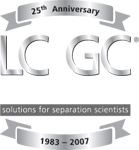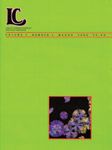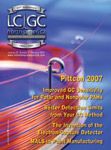Looking back at 25 Years of LCGC
Special Issues
I was first acquainted with LCGC in the mid 1980s. Known then as just LC Magazine, it appealed to any graduate student working in the field of chromatography because it was delivered each month free of charge.
I was first acquainted with LCGC in the mid 1980s. Known then as just LC Magazine, it appealed to any graduate student working in the field of chromatography because it was delivered each month free of charge. Now, I know there is an old axiom that says: "you get what you pay for," but that could not have been farther from the truth for LCGC. Sure, you could go to the library to peruse a copy, but it was great to have a chromatographic resource right at your fingertips on the shelf in your own office, and my issues had my favorite articles all marked by bent page corners (at least until 3M finally came out with "Post-it's"!). Some of what I read I was driven to try, to the point of even convincing (coercing?) my research advisor at the time to purchase the groups' first computer, an Apple II with an A/D converter. No more strip charts for me!

Michael E. Swartz
Each issue of the magazine had many, what we used to call "real world" articles that covered a broad range of topics. One of my personal favorites was John Dolan's "LC Troubleshooting" articles, and reading John's columns and corresponding with him in the early years of my career lead to a professional relationship and personal friendship lasting to this day. It might be just my imagination, but I think I have even been a subject of one or two of John's columns.
I never let my subscription lapse over the years as it became LCGC and went through its various editorial and style changes, and although I may be somewhat biased, I find it just as valuable today. I am sure (much to my wife's chagrin) that I probably have some of those early issues in a box in the attic somewhere but I know I can still go to my companies information center (it is now more than a library!) and leaf through the issues from 1983 right up to 2007, and I still keep the most current issues in my office. I cannot say the same for the old cinder block and plywood shelves, however!
I took the occasion of LCGC's 25th Anniversary to look back at some of those early issues, and what struck me is how much has changed over the years, and how much has remained the same, even in the ten years since I became an editorial advisory board member and started co-authoring the "Validation Viewpoint" column with my first graduate school advisor, Professor Ira Krull.

Instrumentation, column chemistry, and software certainly have evolved over the years, but until recently, with the advent of ultra high pressure LC, you could still perform today's methods on systems over 30 years old. More recently, systems and columns have become commercially available that dramatically increase speed, efficiency, and sensitivity without compromise by relying on sub-2-μm particles and higher pressures (1,2). The desire for fast LC and the use of smaller particles has been around for much longer than LCGC, but the magazine certainly recognized the trend long ago. In one of the first issues, I remember reading after embarking upon my industrial career, an author reported on the practical aspects of "HSLC," or high-speed liquid chromatography (3). In the article, he suggested in the introduction that the future would make way for columns packed with 2-μm modified silica particles, and that both higher pressures and different sample introduction devices would have to be used to realize their full potential. It was suggested that HSLC could be used for reaction monitoring, process control, and optimization of UV detection wavelength for people that didn't have access to a photodiode array detector. However, the author also pointed out some of the early shortcomings of HSLC: heat effects, cycle times, and information overload.
At the time (June 1985), the common column diameter was 4.6 mm, and when using a column 4 cm long, with 3 μm particles, a thermal gradient could be obtained that resulted in peak tailing in the chromatogram (albeit at a flow rate of 6 mL/min.). Of course, modern systems have now overcome this issue by reducing the column diameter, and/or by using pre-column temperature stabilization to reduce the effects to all but immeasurable. However, I also found it somewhat ironic that in the same issue, other researchers were also looking into the effects heat had on the sample, prior to injection, and came up with their own solution (4). Rather than wait 22 years, they made a visit to the local Sears Roebuck store!

Cycle times and information overload were also eventually addressed. With HPLC run times of 30 or more minutes, no one would fault an injector that took a minute or more to inject, or a computer that took a minute to open and close files, write to the disk, etc. However, as run times got much shorter, this "injection overhead" became much more significant, and inject to inject cycle times rather than run times were now measured. Processing speed, and again, improvements in instrumentation and software control has resulted in a significant decrease in injection overhead, so that while the early adopters where amazed at how slow people were to adopt this new approach, today fast chromatography is becoming more the norm than the exception. Modern technology available today from many manufacturers now take true advantage of particles even smaller than 2 μm and the speed, efficiency and sensitivity only previously obtained in R&D laboratories has been reduced to common practice.
One thing that certainly has changed since the early days of LCGC is information management. The shear amounts of data, from a variety of laboratory instruments, have created a significant challenge not only for analyzing the data, but for accessing and mining it further down the road. The use of chromatography data systems, specialized software (for instrument control, data analysis, and even predictions based on theory) and scientific data management systems has given rise to entirely new fields of chemometrics and informatics. I certainly never had that in mind as I set up the new Apple II in Professor Krull's lab!
Another thing that I certainly never imagined back then was that one day I would be writing for the magazine on a regular basis. It was a little over ten years ago that Professor Krull and I approached the LCGC editor at the time about writing a regular column on method validation; a topic that we felt was rapidly becoming an important issue with much of their readership. In the ten years that the "Validation Viewpoint" column has appeared, we have co-authored (along with a few invited guests) over 40 columns on a variety of subjects, and have seen a cottage industry spring up of conferences, symposia, and courses covering many of the same topics, reaffirming our belief that the topic is still important. It is certainly a testament to the forethought of the editors and management at the magazine to recognize that the validation and compliance issues that were coming to the forefront ten years ago would become an important and interesting topic to their readers for many years to come. It certainly has been a pleasure working with the various people at LCGC and Advanstar for all these years, and I greatly appreciate all of the support and the opportunity that they have provided.

What will the next 25 years bring? Of course, no one knows for sure, but I think one thing is definite, and that is that an increased web presence seems inevitable. I can now go straight to the source; my Internet browser favorites folder has replaced my different colored Post-it's. I can find much, if not all of the current LCGC content on-line in an instant, and can even attend live on-line seminars on a variety of subjects, or listen and watch recorded versions to fit my own schedule. Another definite is that more sophisticated separation chemistry, instrumentation, software, and automation, and new ways to apply and utilize it will always be on the horizon, and I know that LCGC Magazine will be there to see it through.
Here's to another 25 years!!
Michael E. Swartz "Validation Viewpoint" Co-Editor Michael E. Swartz is Research Director at Synomics Pharmaceutical Services, Wareham, Massachusetts, and a member of LCGC's editorial advisory board.
References
(1) M.E. Swartz, J. Liq. Chrom. & Rel. Technol. 28(7–8), 1253–1263 (2005).
(2) M.E. Swartz, Separation Science Redefined, Supplement to LCGC May 2005, pp. 8.
(3) S.J. Van der Wal, LCGC 3(6), 488 (1985).
(4) R.C. Simpson and P.R. Brown, LCGC 3(6), 537 (1985).

HPLC 2025 Preview: Fundamentally Speaking (Part 1)
May 13th 2025Michael Lämmerhofer from the Institute of Pharmaceutical Sciences, University of Tübingen, Germany, spoke to JFK Huber Lecture Award winner of 2024 Torgny Fornstedt, professor in analytical chemistry and leader of the Fundamental Separation Science Group, Karlstad University, Sweden, about his pioneering work in high performance liquid chromatography (HPLC) with a focus on fundamentals and industrial applications.
Reversed-Phases for LC Deliberately Doped with Positive Charge: Tips and Tricks for Effective Use
May 13th 2025In this month's edition of LC Troubleshooting, Dwight Stoll and his fellow researchers discuss both the benefits (improved peak shape/loading) and challenges (excessive interaction) associated with charge-doped reversed-phase (RP) columns for both analytical and preparative separations.
Determining Ways to Protect Honeybee Colonies with GC–MS
May 13th 2025A study conducted by the Agriculture Research Centre of Giza, Egypt, and Jilin Agricultural University in China, evaluated the efficacy of stinging nettle extract, nettle smoke, and formic acid in the controlling of Varroa mites, a major threat to honeybee colonies, with a focus on mite infestation reduction, honeybee mortality, and biochemical responses. Gas chromatography–mass spectrometry (GC–MS) was used to identify key bioactive compounds in the stinging nettle extract.

.png&w=3840&q=75)

.png&w=3840&q=75)



.png&w=3840&q=75)



.png&w=3840&q=75)


















